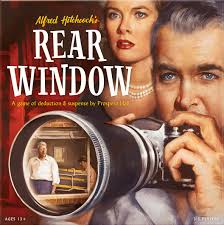Meet Alfred Hitchcock (3): The Role of Setting in Rear Window
Hey, movie lovers! Today, we’re peering through the lens of one of Alfred Hitchcock’s most ingenious films—Rear Window (1954). This suspenseful classic turns the humble apartment into a stage for one of the most gripping narratives in film history. Grab your magnifying glasses and join us as we explore how Hitchcock’s masterful use of setting turns a single location into a thrilling cinematic experience.
In Rear Window, Hitchcock takes the seemingly mundane setting of an apartment complex and transforms it into a dynamic and suspenseful environment. The entire film is set in and around the apartment of L.B. “Jeff” Jefferies (James Stewart), a photographer confined to a wheelchair due to a broken leg. His limited mobility and window vantage point make the setting crucial to the story’s suspense and tension.
- The Apartment: Jeff’s apartment isn’t just a backdrop; it’s where the entire narrative unfolds. The confined space amplifies the feeling of isolation and voyeurism. As Jeff watches his neighbors through his rear window, the apartment becomes a prison from which he observes a world he can’t directly interact with.
- The Courtyard: The courtyard outside Jeff’s window is a mini-world of its own, filled with quirky characters and daily activities. Hitchcock uses this communal space to create a sense of realism and to enhance the tension. The varying activities and interactions of the neighbors provide both a distraction and a source of clues for Jeff’s amateur sleuthing.
Hitchcock’s use of the apartment setting in Rear Window is a masterclass in creating suspense through spatial constraints. Here’s how he does it:
- Limited Perspective: Jeff’s restricted view from his apartment creates a sense of claustrophobia and heightens the tension. The audience sees what Jeff sees, which builds empathy and involvement in his predicament. We’re as trapped and limited in our perspective as Jeff is, making each new discovery or potential danger even more intense.
- Visual Clues: The way Hitchcock frames each window and the view from Jeff’s apartment provides visual clues about the story. Each neighbor’s window reveals snippets of their lives, which helps Jeff—and the audience—piece together the puzzle of a suspected murder. The small details observed from these windows are crucial to the unfolding mystery.
- Surveillance and Voyeurism: The entire plot revolves around the theme of voyeurism. Jeff’s spying on his neighbors through his window is both a plot device and a commentary on the nature of observation. The film cleverly uses this concept to question the ethics of watching others and to build suspense as Jeff uncovers more about his neighbors’ private lives.
The neighbors Jeff observes aren’t just random faces; they add depth to the setting and plot. Each character’s story and behavior contribute to the film’s tension:
- The Thief: The mysterious neighbor who Jeff suspects of murder. His apartment and actions are central to the plot and create the film’s primary suspense.
- The Happy Couple: They provide a contrast to the darker elements of the story, showcasing normalcy and happiness amidst the tension.
- The Lonely Woman: Her presence adds a layer of poignancy and highlights the theme of isolation.
The apartment setting in Rear Window is more than just a location—it’s a character that drives the narrative and enhances the suspense. Hitchcock’s ability to turn a confined space into a thrilling environment is a testament to his genius in using setting to its fullest potential.
Alfred Hitchcock’s Rear Window stands as a brilliant example of how a single setting can be transformed into a suspenseful narrative device. Through its confined space and meticulous design, the film creates an immersive experience that keeps us on the edge of our seats.



TechSavvySam
Thanks for taking the time to create this.
jl3login
Having trouble logging in to jl3login. Anyone else experiencing this? Hopefully, it’s just a temporary glitch. jl3login
alanobet3
Alanobet3, never heard of it ’til recently. Gave it a whirl and it’s alright. Nothing super flashy, but the odds aren’t bad. Depositing was easy enough, which is always a plus. Worth a look if you’re hunting for a new spot. Here’s the link alanobet3.
lotus365 app download
The Lotus365 app download is clutch. It’s so much more convenient than using the website on my phone. Highly recommend grabbing it. You won’t regret it!: lotus365 app download